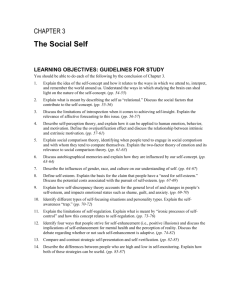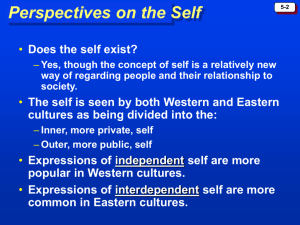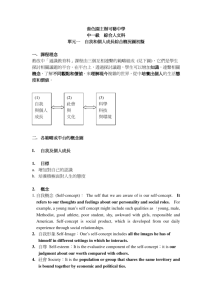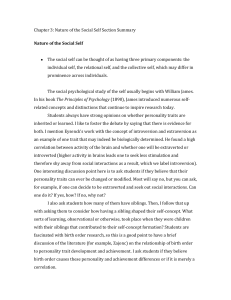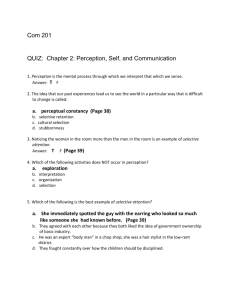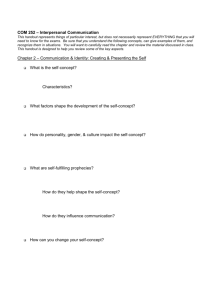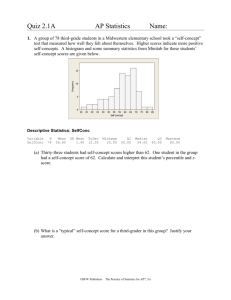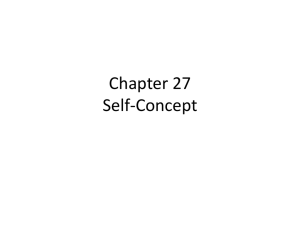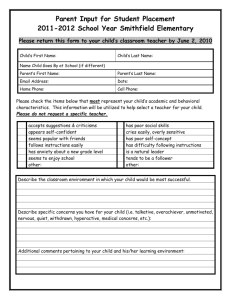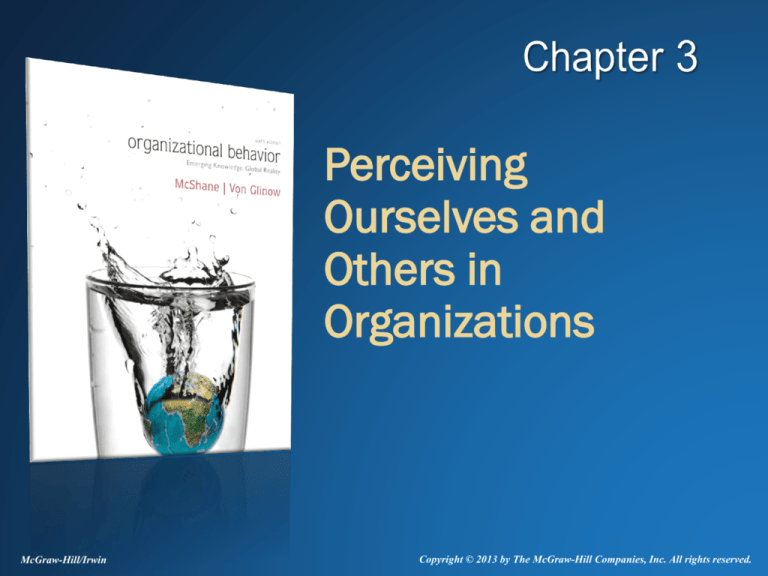
Perceiving
Ourselves and
Others in
Organizations
McGraw-Hill/Irwin
Copyright © 2013 by The McGraw-Hill Companies, Inc. All rights reserved.
Changing Self and OtherPerceptions of Female Firefighters
Camp Fully Involved, a six-day intensive firefighter
course for teenage girls, builds self-confidence and
dissolves the stereotype that firefighting is only for men.
3-2
Self-Concept Defined
An individual’s self-beliefs and self-evaluations
“Who am I?” and “How do I feel about myself?”
Compare perceived job with our perceived and ideal selves.
Includes three self-concept dimensions and four “selves”
processes
3-3
Self-Concept Dimensions (3 C’s)
Complexity
• People have multiple self-views
Consistency
• Similar personality and values across multiple selves
Clarity
• Clearly and confidently described, internally consistent,
and stable across time.
People have better well-being with:
• multiple selves (complexity)
• well established selves (clarity)
• selves are similar and compatible with traits
(consistency)
3-4
Four “Selves” of Self-Concept
Self-enhancement
• Promoting and protecting our positive self-view
Self-verification
• Affirming our existing self-concept
Self-evaluation
• Evaluating ourselves through self-esteem, self-
efficacy and locus of control
Social self
• Defining ourselves in terms of group membership
3-5
Self-Concept: Self-Enhancement
Drive to promote/protect a positive self-view
• competent, attractive, lucky, ethical, valued
Positive self-concept outcomes:
• better personal adjustment and mental/physical
health
• inflates personal causation and probability of
success
3-6
Self-Concept: Self-Verification
Motivation to verify/maintain our self-concept
Stabilizes our self-concept
People prefer feedback consistent with their
self-concept
Self-verification outcomes:
• More likely to perceive information consistent with
our self-concept
• We interact more with those who affirm/reflect our
current self-concept
3-7
Self-Concept: Self-Evaluation
Self-esteem
• High self-esteem -- less influenced, more
persistent/logical
Self-efficacy
• Belief in one’s ability, motivation, role perceptions,
and situation to complete a task successfully
• General vs. task-specific self-efficacy
Locus of control
• General belief about personal control over life
events
• Higher self-evaluation with internal locus of control
3-8
Self-Concept: Social Self
•
Social identity -- defining ourselves in terms of groups
to which we belong or have an emotional attachment
•
We identify with groups that support self-enhancement
Social Identity
Edward Jones
Employee
American
Resident/Citizen
An individual’s
social identity
Indiana U.
Graduate
Contrasting Groups
Employees at
other firms
People living in
other countries
Graduates of
other schools
3-9
Perception Defined
The process of receiving
information about and making
sense of the world around us
• Determining which information
gets noticed
• how to categorize this
information
• how to interpret information
within our existing knowledge
framework
3-10
Selective Attention
Selecting vs ignoring sensory
information
Affected by object and
perceiver characteristics
Emotional markers attached to
selected information
Confirmation bias
• Information contrary to our
beliefs/values is screened out
3-11
Perceptual
Organization/Interpretation
Categorical thinking
• Mostly nonconscious process of organizing
people/things
Perceptual grouping principles
• Similarity or proximity
• Closure -- filling in missing pieces
• Perceiving trends
Interpreting incoming information
• Emotional markers automatically evaluate
information
3-12
Mental Models in Perceptions
Internal representations of the external world
Help make sense of situations
• Fill in missing pieces
• Help to predict events
Problem with mental models:
• May block recognition of new
opportunities/perspectives
3-13
Stereotyping
Assigning traits to people based on
social category membership
Occurs because:
• Categorical thinking
• Innate drive to understand and
anticipate others’ behavior
• Enhances our self-concept
3-14
Stereotyping Through Categorization,
Homogenization, Differentiation
Social identity and self-enhancement
reinforce stereotyping through:
Categorization -- Categorize people into
groups
Homogenization -- Assign similar traits within
a group; different traits to other groups
Differentiation process -- Assign less
favorable attributes to other groups
3-15
Stereotyping Problems/Solutions
Stereotyping Problems
• Overgeneralizes – doesn’t represent everyone in
the category
• Basis of systemic and intentional discrimination
Overcoming stereotype biases
• Difficult to prevent stereotype activation
• Possible to minimize stereotype application
3-16
Attribution Process
Internal
Attribution
Perception that behavior
is caused by person’s
own motivation or ability
External
Attribution
Perception that behavior is
caused by situation or fate
-- beyond person’s control
3-17
Attribution Rules
Internal Attribution
Frequently
Frequently
Seldom
Consistency
Distinctiveness
Consensus
Seldom
Seldom
Frequently
External Attribution
3-18
Attribution Errors
Fundamental Attribution Error
• attributing own actions to internal and external
factors and others’ actions to internal factors
Self-Serving Bias
• attributing our successes to internal factors and
our failures to external factors
3-19
Self-Fulfilling Prophecy Cycle
Supervisor
forms
expectations
Employee’s
behavior matches
expectations
Expectations
affect supervisor’s
behavior
Supervisor’s
behavior affects
employee
3-20
Self-Fulfilling Prophecy Effect is
Strongest...
...at the beginning of the relationship (e.g.
employee joins the team)
...when several people have similar
expectations about the person
...when the employee has low rather than
high past achievement
3-21
Other Perceptual Effects
Halo effect
• One trait affects perception of person’s other traits
False-consensus effect
• overestimate how many others have similar beliefs
or traits like ours
Primacy effect
• First impressions
Recency effect
• Most recent information dominates perceptions
3-22
Strategies to Improve Perceptions
1.
Awareness of perceptual biases
2.
Improving self-awareness
• Applying Johari Window
3.
Meaningful interaction
• Close, frequent interaction toward a shared goal
• Equal status
• Engaged in a meaningful task
3-23
Know Yourself (Johari Window)
Feedback
Known to Self
Known
to Others
Disclosure
Open
Area Open
Area
Hidden
Area
Hidden
Unknown
to Others
Area
Unknown to Self
Blind
Area Blind
Area
Unknown
Unknown
Area
Area
3-24
Meaningful Interaction at
Herschend Family Entertainment
Herschend Family Entertainment
CEO Joel Manby worked incognito
along-side employees as part of
the television program Undercover
Boss. The experience helped
Manby improve his perceptions of
the workplace as well as his own
leadership behavior.
3-25
Global Mindset
An individual’s ability to perceive, appreciate,
and empathize with people from other cultures,
and to process complex cross-cultural
information.
• awareness of, openness to, and respect for other views
and practices in the world
• capacity to empathize and act effectively across
cultures
• ability to process complex information about novel
environments
• ability to comprehend and reconcile intercultural
matters with multiple levels of thinking
3-26
Developing a Global Mindset
1.
Self-awareness activities – understand own
values, beliefs, attitudes
2.
Compare mental models with people from
other cultures
3.
Cross-cultural training
4.
Immersion in other cultures
3-27
Perceiving
Ourselves and
Others in
Organizations

